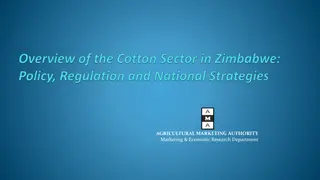Understanding Farmer Organizations and Smallholder Farmers in Agroecology
Exploring various types of farmer organizations, their purposes, and impacts on smallholder farmers in agroecology. A discussion on organizational forms, interventions, challenges faced by smallholders, and the importance of collaboration in achieving collective benefits.
Download Presentation

Please find below an Image/Link to download the presentation.
The content on the website is provided AS IS for your information and personal use only. It may not be sold, licensed, or shared on other websites without obtaining consent from the author. Download presentation by click this link. If you encounter any issues during the download, it is possible that the publisher has removed the file from their server.
E N D
Presentation Transcript
Session 3 Organisational forms, agroecology, and smallholder farmers
Session plan What are the various types of farmer or producer organizations? What is their purpose and the implicit theory of change when designing an intervention targeting organization of farmers? What types of outcomes and impacts different organizational forms (can) lead to, and why. 1. Per Rasmussen (Organic Denmark) will share insights on their experience from working with organic smallholder farmers and various organizational forms Mikael Jonsson (ADDA) and Agea Go-Deos (DUFA): Digitalization and its use in farmer organizations Myles Oelofse (Sustainability and Evaluation Specialist) will wrap the session by presenting evidence from a study of the effect of organizational forms on farm outcomes. This will form the basis of a discssion Discussion 2. 3. 4.
What is a farmer or producer organization? What is a farmer or producer organization? Formal or informal membership-based, collective action institution Differ according to: origin, legal status, membership base, functions, purpose, services provided and scale and level of operations Purpose of assembling and possessing established organizational structure to support members in pursuing their individual and collective interests Producer organisations in supply chains typically have a strong economic function (e.g. marketing, buying farm inputs, processing), but groups also serve other purposes, such as social, environmental or political objectives The term aggregation is sometimes used => scaling information dissemination, logistical support, marketing & distribution
A South African example to think about what farmer types interventions might be working with. Smallholders in SA are a heterogenous group. Different typologies will have different needs
Why organize farmers? Examples of some challenges smallholders typically may face The assumption is that by working together offers a scaling of efforts and thus benefits to farmers
Types and variations Cooperatives The traditional cooperative (bottom up driven) Evolving types (market response, more top-down) Farmer associations and groups Rural self-help groups and women s groups Registered producer groups Informal producer organisations Network organisations Outgrower schemes/contract farming Local trader
A scoping review of the literature on FO services and their impacts on small-scale producers in sub-Saharan Africa and India. Review of 239 studies of farmer organizations in 24 countries
Services offered by producer organizations Review of 239 studies of farmer organizations in 24 countries Bizikova, L., Nkonya, E., Minah, M. et al. A scoping review of the contributions of farmers organizations to smallholder agriculture. Nat Food 1, 620 630 (2020).
Impact areas Review of 239 studies of farmer organizations in 24 countries Bizikova, L., Nkonya, E., Minah, M. et al. A scoping review of the contributions of farmers organizations to smallholder agriculture. Nat Food 1, 620 630 (2020).
Conclusions Most reviewed studies (57%) reported positive FO impacts on farmer income Much fewer reported positive impacts on crop yield (19%) and production quality (20%). Environmental benefits, such as resilience-building and improved water quality and quantity were documented in 24% of the studies. Natural resource management should also be more widely incorporated in the services provided by FOs to mitigate risks associated with environmental degradation and climate change.
Key take homes from the study Key take homes from the study Farmers who are already marginalized because of poor education, land access, social status and market accessibility may require additional support systems to improve their capacities, skills and resources before they are able to benefit from FO membership. Agricultural development requires a differentiated approach tailored to the opportunities and challenges of different categories of farmers, agro-climatic and geographical zones, and value chains.
Questions for consideration in programming Questions for consideration in programming Do you build an understanding of typologies before designing an intervention (broadly) (e.g. through a needs or stakeholder assessment) Which organizational mode have you utilized? Reflect on: Relevance: Is it appropriate to the project area and participants does it explicitly address the needs and objectives of farmers Effectiveness: Is it the most effective way of achieving desired outcomes? Impact: What types of impact can be expected from the organizational form what might some of the unanticipated impacts be? Sustainability: How does the group look five years after project closure?
Why is this important when Why is this important when designing agricultural designing agricultural transformation and rural transformation and rural transitions transitions DFID s Conceptual Framework on Agriculture, 2015























